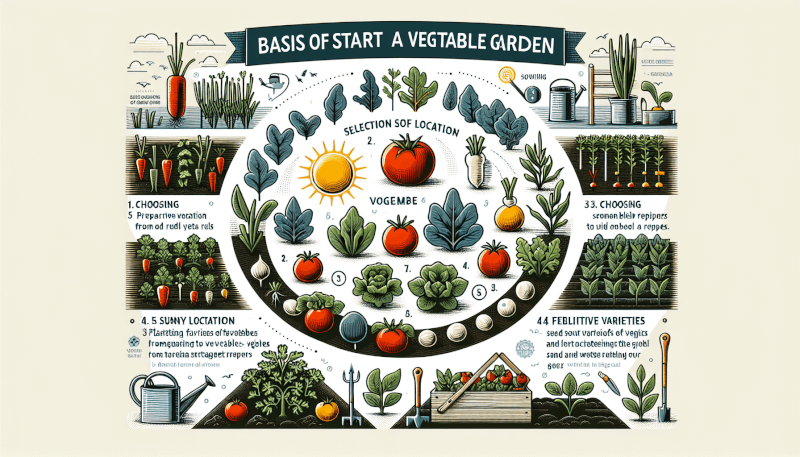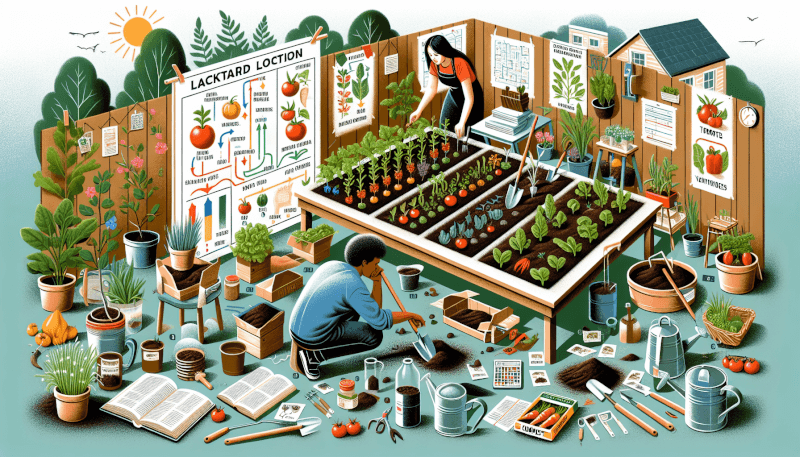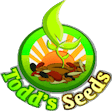So, you’ve decided to embark on the exciting journey of vegetable gardening! Whether you’re a beginner or someone with a green thumb, this article will provide you with essential tips and guidance to get started. From choosing the right location for your garden to selecting the perfect vegetables to grow, we’ll walk you through the process step by step. With a little bit of patience, enthusiasm, and a sprinkle of dirt, you’ll soon be savoring the fresh flavors of your very own homegrown vegetables. Let’s dig in!

Selecting the Right Location
Sunlight requirements
When selecting a location for your vegetable garden, one of the most important factors to consider is the amount of sunlight that the area receives. Most vegetable plants require at least 6 to 8 hours of direct sunlight each day to thrive. Take note of the different areas in your yard and observe how much sun they receive throughout the day. Choose a spot that has the highest amount of sunlight exposure for optimal plant growth.
Soil type and quality
Another crucial aspect to consider when choosing a location for your vegetable garden is the soil type and quality. Different vegetables have different soil requirements, so it’s important to assess the soil in your chosen spot. The ideal soil is well-drained, loose, and rich in organic matter. Heavy clay soils can be amended with compost or other organic matter to improve drainage and fertility. Sandy soils may need additional organic matter to enhance water-retention capabilities. Understanding the soil composition will allow you to prepare it accordingly and ensure the best conditions for your vegetable garden.
Water availability
Water is essential for the growth and development of vegetable plants. When selecting a location, consider the proximity of a water source. It should be easily accessible and provide a reliable water supply for your garden. Adequate water availability is especially important during dry periods or when starting seeds indoors. Ensure that your chosen location can be easily irrigated to keep your plants healthy and productive.
Planning Your Vegetable Garden
Choosing the right vegetables
Before diving into the planning process, it’s crucial to choose the right vegetables for your garden. Consider the climate and growing conditions in your area. Certain vegetables thrive better in certain climates, so it’s essential to select varieties that are well-suited to your region. Additionally, take into account your own preferences and the amount of time you’re willing to invest in maintenance. Choose vegetables that you and your family enjoy eating and that align with the level of commitment you can provide.
Mapping out the garden space
Once you’ve decided on the vegetables you want to grow, it’s time to map out the garden space. Measure the available area and create a rough sketch of your garden layout. Keep in mind the space requirements of each vegetable and their potential growth habits. Group plants with similar requirements together to optimize space utilization and ensure efficient watering and fertilization. This step will help you visualize the garden and make the most of the available space.
Considering companion planting
Companion planting involves strategically placing certain plants next to each other to create mutually beneficial relationships. Some plants repel pests, while others attract pollinators or enrich the soil with nitrogen. Research companion planting principles to optimize the growth and health of your vegetables. For example, planting marigolds next to tomatoes can help repel pests, while planting basil near peppers can improve their flavor and growth. The concept of companion planting adds another layer of planning to ensure a successful vegetable garden.
Preparing the Soil
Clearing the area
Before preparing the soil, it’s important to clear the selected area of any existing vegetation or debris. Remove weeds, grass, and any other plants that may compete with your vegetables for nutrients, sunlight, and space. Using a shovel or a garden tiller, turn over the soil to expose the roots of the unwanted plants. This process will make it easier to remove them and create a clean slate for your vegetable garden.
Loosening the soil
Once the area is cleared, it’s time to loosen the soil. This step is crucial for root penetration, water drainage, and nutrient absorption. Use a garden fork or a tiller to break up any compacted soil. Loosening the soil will also make it easier to mix in compost and organic matter, which are essential for improving soil fertility and structure.
Adding compost or organic matter
To provide the necessary nutrients for your vegetable plants, it’s important to add compost or organic matter to the soil. Compost is rich in organic material and helps retain moisture, improve soil structure, and enhance nutrient availability. Spread a layer of compost over the soil and work it into the top few inches. Alternatively, you can use other organic matter such as well-rotted manure or leaf mulch. This addition will benefit your vegetable garden by promoting healthy plant growth and productivity.

Starting Seeds vs. Buying Plants
Advantages of starting seeds
Starting seeds indoors allows you to have greater control over the growing process, resulting in healthier and more vigorous plants. By starting seeds early, you can extend the growing season and potentially have an earlier harvest. It also provides a wider selection of vegetable varieties to choose from, as some seeds may not be readily available as transplants. Starting seeds is a cost-effective option, as it is generally cheaper than buying established plants. It is a rewarding process that allows you to witness the complete life cycle of your plants, from seed to harvest.
Purchasing quality plants
If you don’t have the time, space, or resources to start seeds indoors, buying quality plants from a reputable nursery is a viable option. Nursery-grown plants are already established and ready to be transplanted into your garden. Buying plants saves time and effort, especially if you’re new to gardening or have limited experience with seed starting. Ensure that you choose healthy plants with no signs of disease or stress. This will give your vegetable garden a head start and increase the likelihood of a successful harvest.
Factors to consider for each option
When deciding whether to start seeds or buy plants, there are several factors to consider. Time is a significant factor, as starting seeds indoors requires more time and attention than purchasing plants. Space availability is also important, as seed starting requires adequate space for germination, growth, and hardening off before transplanting. Consider the cost, as purchasing seeds and potting mix for seed starting can add up, but buying plants can be more expensive per plant. Assess your skills, experience, and confidence level in seed starting to make an informed decision for your vegetable garden.
Seed Selection and Sowing
Choosing the right seeds
Selecting the right seeds is crucial for the success of your vegetable garden. Consider the growing conditions in your area, such as average temperatures and length of the growing season. Look for seeds that are adapted to your climate zone and have a shorter maturity time if you have a shorter growing season. Pay attention to the recommended planting depth and spacing for each seed variety to ensure proper germination and optimal growth.
Understanding planting zones
Understanding your planting zone is essential when selecting seeds. Planting zones are determined by factors such as average annual minimum temperatures and frost dates. The United States Department of Agriculture (USDA) has developed a plant hardiness zone map to help gardeners determine which plants are likely to thrive in their region. By knowing your planting zone, you can choose seeds that are suitable for your climate and have a higher chance of success.
Sowing seeds indoors or directly in the garden
The decision to sow seeds indoors or directly in the garden depends on various factors, such as the type of vegetable, the length of your growing season, and local climate conditions. Some vegetables, like tomatoes and peppers, benefit from an early start indoors to allow for a longer growing period. On the other hand, vegetables like carrots and beans are best sown directly in the garden as they do not tolerate transplanting well. Follow the instructions on the seed packet for specific recommendations on when and how to sow the seeds for optimal germination and growth.
Watering and Irrigation
Determining watering needs
Water is crucial for the health and growth of your vegetable plants. The amount of water your garden requires depends on various factors, such as the type of soil, the weather conditions, and the stage of plant growth. It’s important to water deeply and at the root level to encourage strong root development. Monitor the moisture levels in the soil by sticking your finger about an inch below the surface. If it feels dry, it’s time to water. Aim for a consistent and regular watering schedule to keep your plants hydrated but not waterlogged.
Different irrigation methods
There are various irrigation methods to choose from, depending on the size of your garden and your personal preferences. One common method is hand watering with a watering can or hose, allowing you to target the plants directly. Drip irrigation is another efficient option, as it delivers water directly to the plant roots, minimizing water wastage. Soaker hoses and sprinklers are also popular choices. Whichever method you choose, ensure that water is distributed evenly and reaches the plants’ root zones effectively.
Proper watering techniques
To ensure proper watering, there are a few techniques you can employ. Water in the morning or evening to minimize water loss through evaporation. Avoid watering during the hottest part of the day to prevent leaf burn and fungal diseases. Water the soil, not the leaves, as wet foliage can promote the growth of diseases. Slow and deep watering encourages the roots to grow deeper and makes the plants more drought-resistant. Adjust your watering frequency and duration based on the weather conditions, ensuring that your plants receive the right amount of moisture throughout the growing season.
Providing Nutrients and Fertilization
Understanding soil nutrients
Understanding the nutrient needs of your vegetable plants is essential for their growth and productivity. The primary macronutrients required by plants are nitrogen, phosphorus, and potassium. Nitrogen promotes leaf and stem growth, phosphorus supports root development and flower and fruit production, while potassium contributes to overall plant health and disease resistance. Secondary macronutrients, such as calcium, magnesium, and sulfur, are also important, albeit required in smaller quantities. Additionally, plants need various micronutrients, including iron, manganese, and zinc, for proper functioning and development.
Choosing the right fertilizer
Choosing the right fertilizer for your vegetable garden depends on your specific soil conditions and the nutrient requirements of the plants. Organic fertilizers, such as compost and well-rotted manure, add nutrients to the soil while improving its structure and water-holding capacity. They release nutrients slowly and promote soil health. Synthetic fertilizers, on the other hand, provide nutrients in a more concentrated form and can be tailored to specific nutrient deficiencies. Whichever type of fertilizer you choose, follow the application instructions carefully and avoid over-fertilizing, as excessive nutrients can harm plants and the environment.
When and how to fertilize
Timing is crucial when it comes to fertilizing your vegetable garden. Understanding the growth stages of your plants and their nutrient requirements will help you determine when to apply fertilizer. Generally, it’s beneficial to incorporate organic matter or compost into the soil before planting to provide a nutrient-rich foundation. During the growing season, you can apply additional fertilizer in the form of side dressings or liquid solutions to meet the plants’ needs. Fertilize before heavy rain or water your plants after fertilizing to prevent nutrients from leaching away. Regularly monitor your plants for signs of nutrient deficiencies or excesses and adjust your fertilization schedule accordingly.
Mulching and Weed Control
Benefits of mulching
Mulching is an important practice in vegetable gardening that offers numerous benefits. It helps suppress weed growth by blocking sunlight from reaching weed seeds. Mulch also helps conserve moisture by reducing evaporation from the soil surface, allowing your plants to better withstand dry conditions. Additionally, mulch moderates soil temperature, keeping it cool in hot weather and warm in colder temperatures. By preventing soil erosion, mulch promotes overall soil health and reduces the risk of nutrient loss. It also gives your garden a neat and tidy appearance.
Choosing appropriate mulch
When it comes to choosing the right mulch for your vegetable garden, there are several options to consider. Organic mulches, such as straw, wood chips, or compost, provide additional nutrients as they break down and contribute to soil fertility. Inorganic mulches, like plastic or landscape fabric, are effective at weed suppression but do not add nutrients to the soil. Choose a mulch that suits your preferences, budget, and aesthetic considerations. Consider factors such as availability, cost, water permeability, and ease of application and maintenance.
Methods for weed prevention
Weed control is a continuous battle in any vegetable garden. However, implementing certain practices can help minimize weed growth and make the task more manageable. Mulching is one of the most effective methods, as mentioned earlier. Applying a layer of mulch around your plants helps prevent sunlight from reaching weed seeds, reducing germination rates. Regularly hand-pulling or hoeing any emerging weeds will also help keep them in check. Be vigilant and weed frequently to prevent weeds from establishing deep root systems or going to seed. Ultimately, a combination of mulching and diligent weed prevention efforts will lead to a weed-free vegetable garden.
Pest and Disease Management
Common garden pests
Protecting your vegetable garden from pests is essential to ensure a bountiful harvest. Some common garden pests include aphids, cabbage worms, slugs, and tomato hornworms. These pests can damage your plants by feeding on their leaves, stems, or fruits. Employ preventive measures such as crop rotation, physical barriers, and companion planting to deter pests. Regularly inspect your plants for signs of pest activity and take appropriate action to control their populations. Natural predators, like ladybugs and beneficial wasps, can also be encouraged to help keep pest populations in check.
Identifying and treating diseases
Vegetable plants can be susceptible to various diseases, such as powdery mildew, blight, and root rot. Identifying the signs and symptoms of diseases early on is crucial for effective management. Keep an eye out for wilting, discoloration, spots, or mold-like growth on the leaves, stems, or fruits. Practice good sanitation by removing and disposing of any infected plant material. Fungicides and organic disease control products can be used when necessary, following the instructions carefully. Proper spacing, providing good air circulation, and adequate watering practices can help prevent the development and spread of diseases in your vegetable garden.
Eco-friendly pest control methods
Maintaining a healthy and balanced ecosystem in your vegetable garden is crucial for long-term pest control. There are several eco-friendly methods you can employ to combat pests while minimizing harm to beneficial insects and the environment. Introduce natural predators, such as ladybugs, lacewings, or praying mantises, to help control pest populations. Use organic or homemade pest control solutions, such as insecticidal soaps or neem oil, which are less harmful to beneficial insects. Implement physical barriers, like row covers or netting, to protect your plants from insects and birds. By adopting these eco-friendly methods, you can effectively manage pests while promoting biodiversity and sustainability in your garden.
Tips for Success
Starting small
If you’re new to vegetable gardening or have limited space, it’s wise to start small. Begin with a small plot or a few containers and gradually expand as you gain experience. Starting small allows you to focus on a manageable area, learn from any mistakes, and build confidence. It also helps prevent overwhelming yourself with maintenance tasks and ensures that you have the time and resources to properly care for your plants. As you become more comfortable with gardening, you can expand your vegetable garden and try growing a wider variety of crops.
Regular monitoring and observation
Regular monitoring and observation are key to a successful vegetable garden. Take the time to inspect your plants regularly for signs of pests, diseases, nutrient deficiencies, or other problems. Look for insect eggs, unusual leaf discoloration, wilting, or any changes in growth patterns. Early detection allows for prompt action and minimizes the risk of the issue worsening. Keep a close eye on watering needs, especially during hot, dry periods. Being attentive to your plants’ needs and addressing any issues promptly will help ensure healthy growth and a productive vegetable garden.
Keeping a gardening journal
Keeping a gardening journal is a valuable tool for tracking your gardening journey and learning from your experiences. Record important information such as planting dates, varieties planted, growth observations, pest and disease incidences, and yields. Take note of successful techniques, as well as any failures or challenges you encountered. This journal will serve as a reference for future seasons and help you make informed decisions based on your previous experiences. It’s also a great way to reflect on your progress and celebrate your achievements as your vegetable garden thrives and brings you an abundance of fresh, homegrown produce.
In conclusion, starting a vegetable garden can be a rewarding and enjoyable experience. By carefully selecting the right location, planning your garden layout, preparing the soil, and choosing the appropriate seeds or plants, you set yourself up for success. Adequate watering, proper fertilization, mulching, and pest and disease management are essential for healthy plant growth and productivity. With regular monitoring, observation, and the help of a gardening journal, you can learn from your experiences and continually improve your vegetable gardening skills. So roll up your sleeves, get your gardening tools ready, and embark on the journey of growing your own delicious and nutritious vegetables. Your taste buds and your health will thank you!
